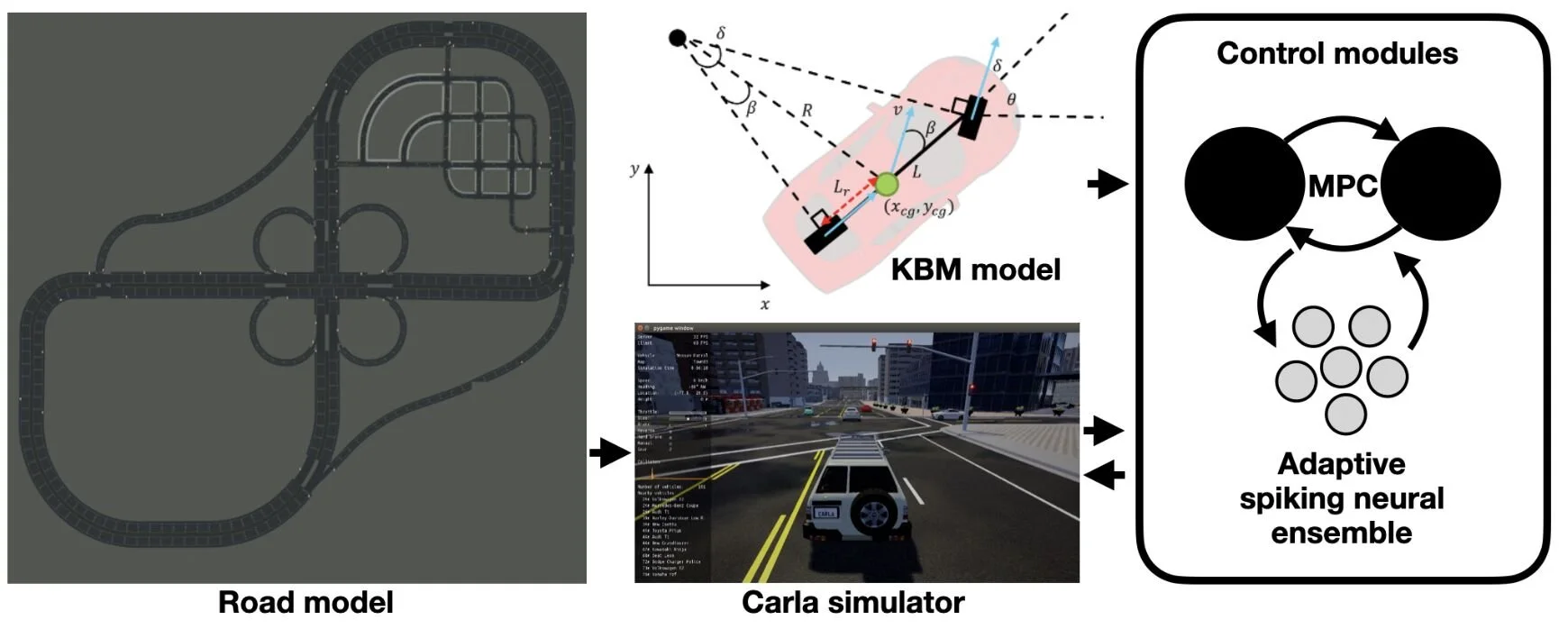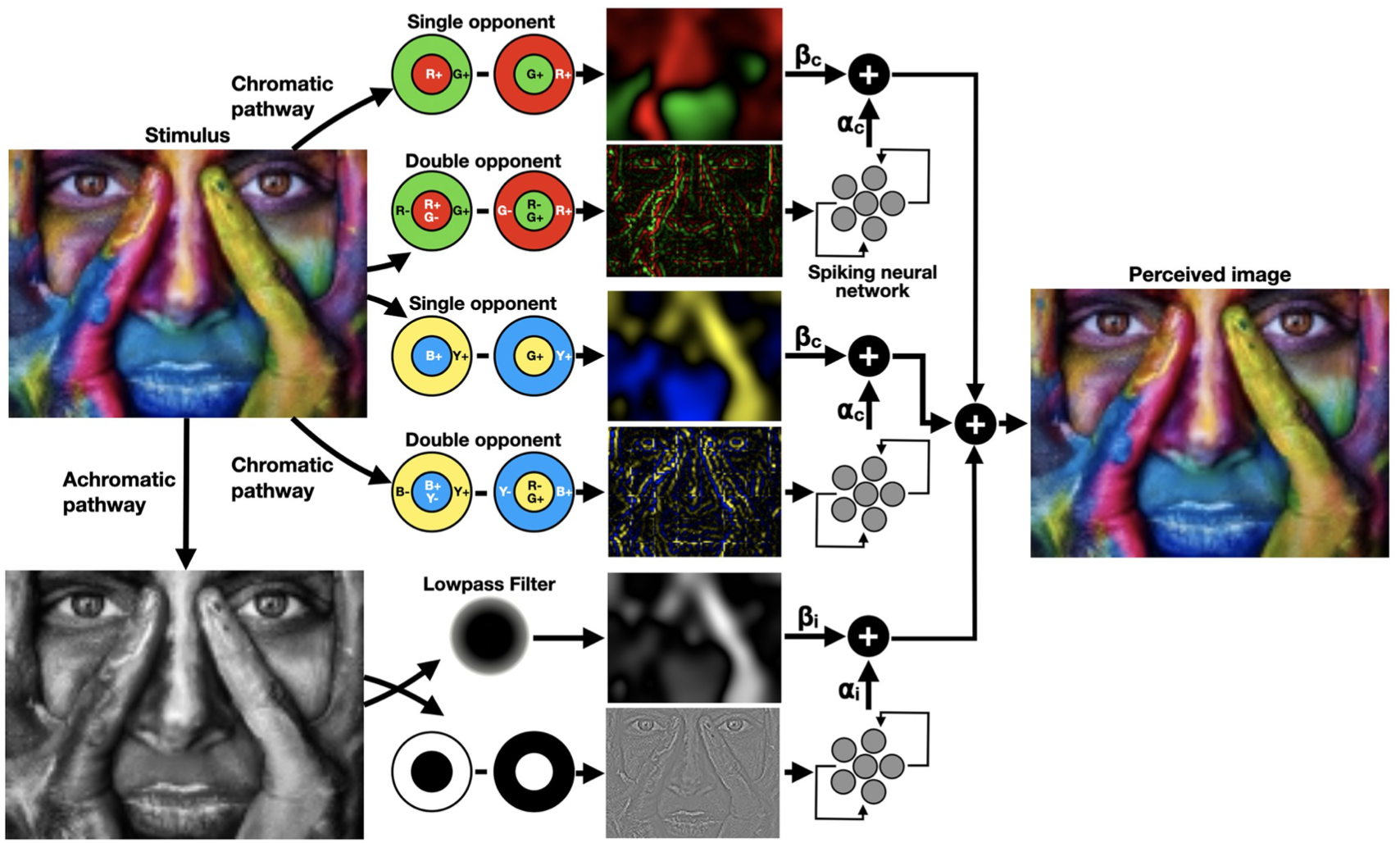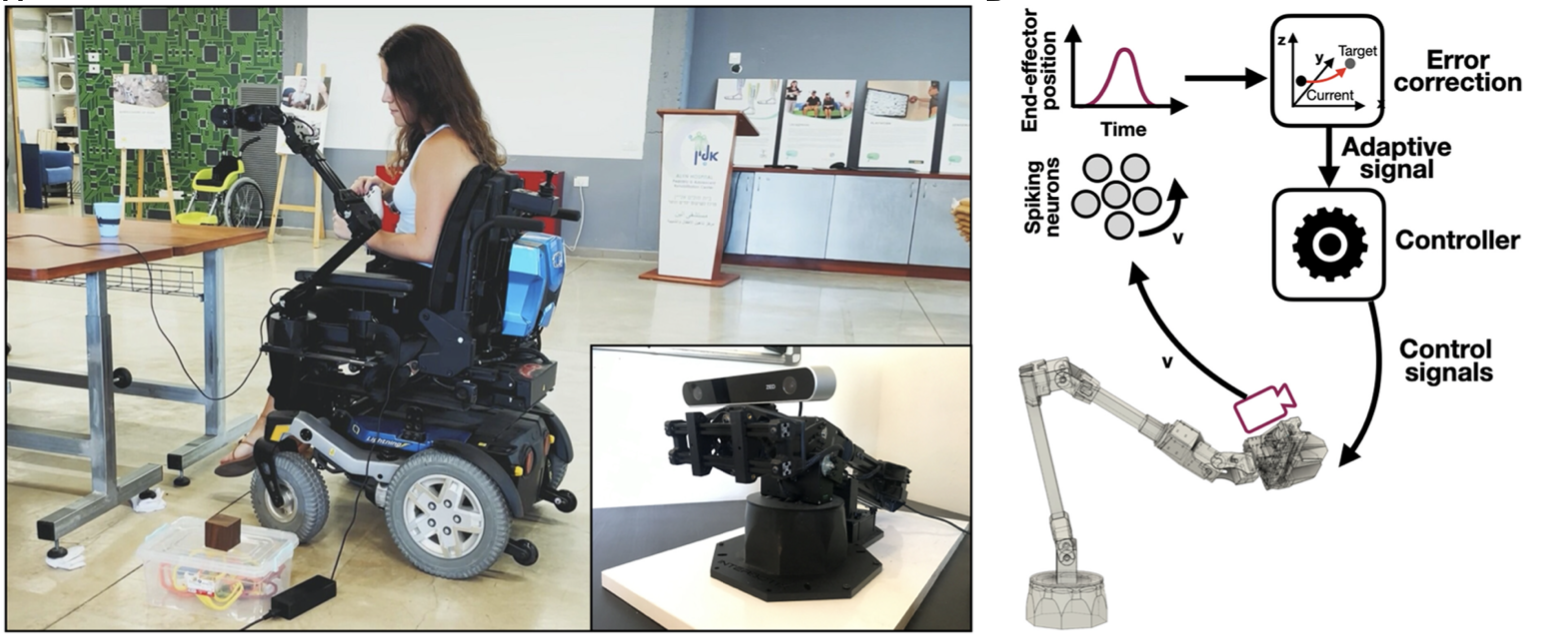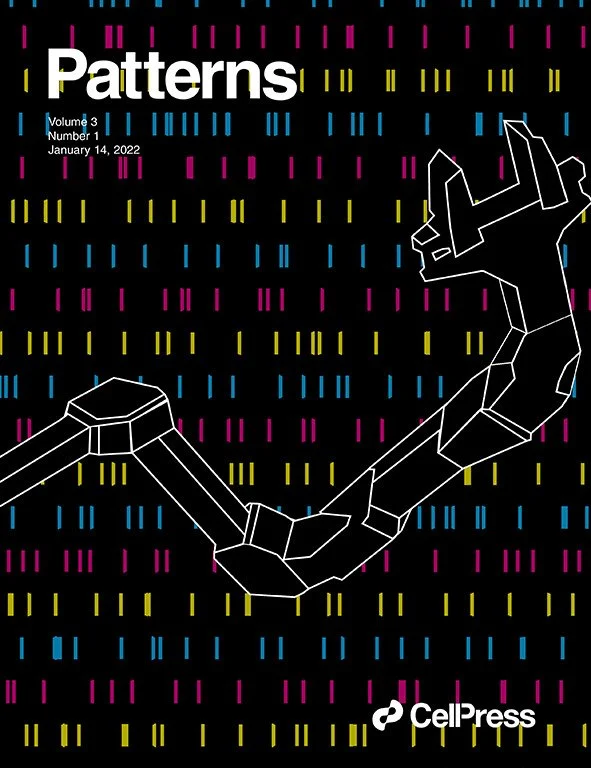Highlighted Research
COGSCI 2025: THE ANNUAL MEETING OF THE COGNITIVE SCIENCE SOCIETY
Feedback-correcting ConvLSTM-driven Neural Model for Stable Saccadic Visual Perception [PDF]
Hadar Cohen-Duwek, Israel Clark, Elishai Ezra Tsur
The brain utilizes corollary discharge signals to anticipate the visual consequences of saccadic eye movements and provide a coherent visual perception. However, discrepancies between a saccade’s predicted and actual sensory outcomes challenge the brain’s capacity to maintain visual stability. In this work, we introduce a comprehensive computational framework for visual perception incorporating a feedback corrective mechanism that dynamically adjusts predictions based on sensory discrepancies. We demonstrate that this feedback mechanism refines internal world models, yielding robust performance with an increasing number of saccades. Our results highlight the delicate balance between the benefits and vulnerabilities of predictive feedback systems, supporting and extending current theories of sensory prediction and visual stability.
COGSCI 2024: THE ANNUAL MEETING OF THE COGNITIVE SCIENCE SOCIETY
Reconstruction of Visually Stable Perception from Saccadic Retinal Inputs Using Corollary Discharge Signals-Driven ConvLSTM Neural Networks [PDF]
Yahia Showgan, Hadar Cohen-Duwek, Elishai Ezra Tsur
While subjective visual experiences are remarkably stable and coherent, their underlying data is incomplete and heavily influenced by the eyes’ saccadic rhythm. In this work, we show that neural networks can effectively reconstruct vibrant images from retinal inputs during active vision. We demonstrate the importance of long- and short-term memory and corollary discharge signals to image stabilization and the system’s sensitivity to noise, corresponding to recent experimental findings. Our study contributes to the advancement of realistic and dynamic models for image reconstruction, providing insights into the complexities of active visual perception.
CVPR workshop for embedded vision, 2024
ED-DCFNet: an Unsupervised Encoder-Decoder Neural Model for Event-driven Feature Extraction and Object Tracking [PDF]
Raz Ramon, Hadar Cohen-Duwek, Elishai Ezra Tsur
Neuromorphic cameras feature asynchronous event-based pixel-level processing and are particularly useful for object tracking in dynamic environments. In this work, we introduce EDDCFNet, a small and efficient (<72k ) unsupervised multidomain learning framework for embedded vision, which extracts events-frames shared features without requiring annotations, showing comparable object tracking performance to existing - much larger - designs.
Neuromorphic computing and engineering, 2024
Continuous Adaptive Nonlinear Model Predictive Control using Spiking Neural Networks and Real-time Learning [PDF]
Raz Halaly, Elishai Ezra Tsur
Following our recent work on neuromorphic algorithms for autonomous driving, in this work, we implemented a continuous adaptive nonlinear model predictive control (MPC) using spiking neural networks. Utilizing real-time learning, our design significantly reduces dynamic error and augments control accuracy, while simultaneously addressing unforeseen situations. We evaluated our framework using real-world scenarios in autonomous driving and tested it with models of various vehicles (from a Tesla Model 3 to an Ambulance) experiencing malfunctioning and swift steering scenarios. We demonstrate significant improvements over traditional MPC implementations.
Bioinspiration and Biomimetics, 2024
Colorful Image Reconstruction from Neuromorphic Event Cameras with Biologically-inspired Deep Color Fusion Neural Networks [PDF].
Hadar Cohen Duwek, Elishai Ezra Tsur
Neuromorphic event-based cameras communicate transients in luminance instead of frames, providing visual information with a fine temporal resolution, high dynamic range, and high signal-to-noise ratio. Enriching event data with color information allows for the reconstruction of colorful frame-like intensity maps, supporting improved performance and visually appealing results in various computer vision tasks. In this work, we simulated a biologically inspired color fusion system featuring a three-stage convolutional neural network for reconstructing color intensity maps from event data and sparse color cues. Our design uses event data and low-spatial and tonal-resolution quantized color cues, providing a high-performing small model for efficient colorful image reconstruction and paving the way for more efficient hardware designs.
Frontiers in Neurorobotics, 2023
Autonomous Driving Controllers with Neuromorphic Spiking Neural Networks [PDF].
Raz Halaly, Elishai Ezra Tsur
Autonomous driving is one of the hallmarks of artificial intelligence. In this work, we have explored neuromorphic implementations of four prominent controllers for autonomous driving: pure-pursuit, Stanley, PID, and MPC, using a physics-aware simulation framework. We extensively evaluated these models with various intrinsic parameters and compared their performance with conventional CPU-based implementations.
COGSCI 2023: THE ANNUAL MEETING OF THE COGNITIVE SCIENCE SOCIETY
Perceptual Colorization of the Peripheral Retinotopic Visual Field using Adversarially- Optimized Neural Networks [PDF].
Hadar Cohen-Duwek, Yahia Showgan, Elishai Ezra Tsur
In this work, we computationally emulated foveated color maps and intensity channels as well as intra-saccadic motion data using a neuromorphic event camera. We used a convolutional neural network, U-Net, and adversarial optimization to demonstrate how retinal inputs can be used for the reconstruction of colorful images in high resolution.
plos computational biology, 2022
Computational Modeling of Color Perception with Biologically Plausible Spiking Neural Networks [PDF].
Hadar Cohen-Duwek, Hamutal Slovin, Elishai Ezra Tsur
In this work, we propose a novel, biologically plausible spiking neural network, for the reconstruction of colorful images from retinal inputs. We compared our results to experimentally obtained V1 neuronal activity maps in a macaque monkey using voltage-sensitive dye imaging and used the model to demonstrate and critically explore color constancy, color assimilation, and ambiguous color perception. Our model allows the attribution of perceptual differences to the proportions between the single and double opponent cells’ activity while being general enough to account for a wide range of visual phenomena.
Frontiers in Neuroscience, 2022
Adaptive Control of a Wheelchair-Mounted Robotic Arm with Neuromorphically Integrated Velocity Readings and Online Learning [PDF].
Michael Ehrlich, Yuval Zaidel, Patrice L. Weiss, Arie Melamed Yekel, Naomi Gefen, Lazar Supic, Elishai Ezra Tsur
We demonstrated adaptive control of a wheelchair-mounted robotic arm. We pilot-tested the device with an able-bodied participant to evaluate its accuracy while performing ADL (activities of daily living) related trajectories. We further demonstrated the capacity of the controller to compensate for unexpected inertia-generating payloads using online learning in real-time. We used proprioceptive feedback provided by an accelerometer in conjunction with a neuromorphic integrator to continuously provide the system with the robot’s current state in real time.
Our work: “Data-driven artificial and spiking neural networks for inverse kinematics in neurorobotics”, is now on the cover of the January 2022 issue of patterns!
Patterns, 2022
Data-Driven Artificial and Spiking Neural Networks for Inverse Kinematics in Neurorobotics [PDF].
Alex Volinski, Yuval Zaidel, Albert Shalumov, Travis DeWolf, Lazar Supic, Elishai Ezra Tsur.
In this work, we demonstrate hundreds of neuronal architectures (ANNs, ResNETs, SNNs (NengoDL), online learning (PES), and the first demonstration of ABR's Gyrus framework) for inverse kinematics in complex environments.
plos computational biology, 2021
Realistic Retinal Modeling Unravels the Differential Role of Excitation and Inhibition to Starburst Amacrine Cells in Direction Selectivity [PDF].
Elishai Ezra Tsur, Oren Amsalem, Lea Ankri, Pritish Patil, Idan Segev, Michal Rivlin-Etzion.
We used a retinal modeling environment we developed - RSME - to decipher one of the most fundamental yet elusive visual processing in the retina: directional selectivity
Bioinspiration & Biomimetics, 2021
LiDAR-Driven Spiking Neural Network for Collision Avoidance in Autonomous Driving [PDF].
Albert Shalumov, Raz Halaly, Elishai Ezra Tsur.
Controlling an autonomous vehicle for neuromorphic LiDAR-driven spiking neural networks (following biologically plausible basal-ganglia and thalamus neural models) for collision avoidance and steering control. We used a neuromorphic PID for the vehicle's speed and devised a null controller and target reaching optimizer for trajectory planning.
CogSci 2021: the Annual Meeting of the Cognitive Science Society
Biologically Plausible Spiking Neural Networks for Perceptual Filling-In [PDF].
Hadar Cohen-Duwek, Elishai Ezra Tsur.
Demonstrating spiking neural networks with which surfaces and objects can be reconstructed from edges neuromorphically.
CVPR 2021 Workshop on Event-based Vision
Image Reconstruction From Neuromorphic Event Cameras Using Laplacian-Prediction and Poisson Integration With Spiking and Artificial Neural Networks [PDF].
Hadar Cohen Duwek, Albert Shalumov, Elishai Ezra Tsur.
Demonstrating a spiking neural network for image reconstruction from neuromorphic visual sensors. Our network design comprises a CNN, optimized for Laplacian prediction, and a Spiking Neural Network optimized for Poisson integration. By introducing Laplacian prediction into the pipeline, we provide image reconstruction with a network comprising only 200 parameters.
Frontiers in Neuroscience, 2021, 15:627221
Neuromorphic Analog Implementation of Neural Engineering Framework-Inspired Spiking Neuron for High-Dimensional Representation [PDF].
Avi Hazan, Elishai Ezra Tsur.
Presenting OZ: a novel programable analog implementation of Neural Engineering Framework (NEF)-inspired spiking neuron. OZ neurons can be dynamically programmed to feature varying high-dimensional response curves with positive and negative encoders for a neuromorphic distributed representation of normalized input data.
Frontiers in neurorobotics, 2021, 15:631159
Neuromorphic NEF-Based Inverse Kinematics and PID Control [PDF].
Yuval Zaidel, Albert Shalumov, Alex Volinski, Lazar Supic, Elishai Ezra Tsur
A new NEF-based neuromorphic algorithms for inverse kinematics and PID control. We used online learning for inverse kinematics and neuromorphic signal integration and differentiation for PID control, offering high performing and energy-efficient control. Algorithms were evaluated in simulation as well as on Intel’s Loihi neuromorphic hardware.
Neurocomputing, 2020, 374: 54-63
Neuromorphic Implementation of Motion Detection Using Oscillation Interference [PDF].
Elishai Ezra Tsur, Michal Rivlin-Etzion
A new neuromorphic algorithm, in which an array of neuro-oscillators is utilized to detect motion and its direction. Oscillators are induced via phase shifted Gabor functions, allowing them to oscillate in response to motion in one predefined direction, and to dump to zero otherwise. This algorithm extends the existing growing set of approaches aiming at utilizing neuromorphic hardware for vision processing, which enable to minimize energy exploitation and silicon area while enhancing computational capabilities.
Full Publication List
Feedback-correcting ConvLSTM-driven Neural Model for Stable Saccadic Visual Perception. Hadar Cohen-Duwek, Israel Clark, Elishai Ezra Tsur. Elishai Ezra Tsur. Proceedings of the Annual Meeting of the Cognitive Science Society (CogSci), 2025 [link]
Passively listening to Mozart’s sonata K. 448 enhances verbal working memory performance: a quantitative EEG study. Sapir Cohen, Elishai Ezra Tsur, Oded Meiron. Current Psychology, 2025: 10.1007/s12144-025-07755-6 [link]
Editorial: Brain-inspired Autonomous Driving. Elishai Ezra Tsur, Gianluca Di Flumeri, Hadar Cohen Duwek. Frontiers in Neurorobotics, 2025, 19:1543115 [link]
Emotional Arousal of Female Politicians: Distinguishing Enthusiasm and Anger Using Data Augmentation and Machine Learning. Hilla Goren Barnea, Vered Silber-Varod, Elishai Ezra Tzur. Proceedings of Artificial Intelligence and Speech Technology (AIST), 2024, Communications in Computer and Information Science, vol 2389. Springer: 10.1007/978-3-031-91331-0_23 [link]
Reconstruction of Visually Stable Perception from Saccadic Retinal Inputs using Corollary Discharge Signals-driven convLSTM Neural Networks. Yahia Showgan, Hadar Cohen-Duwek, Elishai Ezra Tsur. Proceedings of the Annual Meeting of the Cognitive Science Society (CogSci), 2024, 46 [link]
ED-DCFNet: An Unsupervised Encoder-Decoder Neural Model for Event-driven Feature Extraction and Object Tracking. Raz Ramon, Hadar Cohen-Duwek, Elishai Ezra Tsur. Proceedings of the IEEE/CVF Conference on Computer Vision and Pattern Recognition (CVPR) Workshops, 2024, pp. 2191-2199 [link]
Continuous Adaptive Nonlinear Model Predictive Control using Spiking Neural Networks and Real-time Learning. Raz Halaly, Elishai Ezra Tsur. Neuromorphic Computing and Engineering, 2024: 10.1088/2634-4386/ad4209 [link]
Intelligent Robotics in Pediatric Cooperative Neurorehabilitation: A Review. Elishai Ezra Tsur, Odelia Elkana. Robotics, 2024, 13(3): 49 [link]
Colorful Image Reconstruction from Neuromorphic Event Cameras with Biologically-inspired Deep Color Fusion Neural Networks. Hadar Cohen-Duwek, Elishai Ezra Tsur. Bioinspiration & Biomimetics, 2024: 10.1088/1748-3190/ad2a7c [link]
Unsupervised Style Transfer of Modern Hebrew using Generative Language Modeling and Zero-Shot Prompting. Pavel Kaganovich, Ophir Münz-Manor, Elishai Ezra-Tsur. Proceedings of the IEEE International Conference on Big Data (BigData), 2023, 391-412 [link]
Style Transfer of Modern Hebrew Literature Using Text Simplification and Generative Language Modeling. Pavel Kaganovich, Ophir Münz-Manor, Elishai Ezra-Tsur. Proceedings of the Computational Humanities Research Conference (CHR), 2023, 391-412 [link]
Autonomous Driving Controllers with Neuromorphic Spiking Neural Networks. Raz Halaly, Elishai Ezra Tsur. Frontiers in Neurorobotics, 2023, 17:1234962 [link]
Perceptual Colorization of the Peripheral Retinotopic Visual Field using Adversarially-Optimized Neural Networks. Hadar Cohen-Duwek, Yahia Showgan, Elishai Ezra Tsur. Proceedings of the Annual Meeting of the Cognitive Science Society (CogSci), 2023, 45 [link]
Adaptive Attention with a Neuromorphic Hybrid Frame and Event-based Camera. Avinoam Bitton, Hadar Cohen Duwek, Elishai Ezra Tsur. Proceedings of the IEEE International Conference on Cognitive Informatics & Cognitive Computing (ICCI*CC), 2022 [link]
Neuromorphic Analog Implementation of Reservoir Computing for Machine Learning. Avi Hazan, Elishai Ezra Tsur. Proceedings of the IEEE International Conference on Electronics, Circuits and Systems (ICECS), 2022 [link]
Computational Modeling of Color Perception with Biologically Plausible Spiking Neural Networks. Hadar Cohen Duwek, Hamutal Slovin, Elishai Ezra Tsur. PLoS Computational Biology, 2022, 18(10): e1010648 [link]
Biologically Plausible Illusionary Contrast Perception with Spiking Neural Networks.
Hadar Cohen Duwek, Elishai Ezra Tsur. Proceedings of the International Conference on Image Processing (ICIP), 2022 [link]Adaptive Control of a Wheelchair-Mounted Robotic Arm with Neuromorphically Integrated Velocity Readings and Online Learning. Michael Ehrlich, Yuval Zaidel, Patrice L. Weiss, Arie Melamed Yekel, Naomi Gefen, Lazar Supic, Elishai Ezra Tsur. Frontiers in Neuroscience, 2022, 10.3389/fnins.2022.1007736 [link]
Neuromorphic Neural Engineering Framework-Inspired Online Continuous Learning with Analog Circuitry. Avi Hazan, Elishai Ezra Tsur. Applied Sciences, 2022, 12: 4528 [link]
Walking on the Thin Intersectional Lines of Disciplines. Elishai Ezra-Tsur, Travis DeWolf, Lazar Supic. Patterns, 2022: 10.1016/j.patter.2021.100413 [link]
Data-Driven Artificial and Spiking Neural Networks for Inverse Kinematics in Neurorobotics. Alex Volinski, Yuval Zaidel, Albert Shalumov, Travis DeWolf, Lazar Supic, Elishai Ezra Tsur. Patterns, 2022: 10.1016/j.patter.2021.100391, Featured on the Journal’s cover [link]
Realistic Retinal Modeling Unravels the Differential Role of Excitation and Inhibition to Starburst Amacrine Cells in Direction Selectivity. Elishai Ezra-Tsur, Oren Amsalem, Lea Ankri, Pritish Patil, Idan Segev, Michal Rivlin-Etzion. PLoS Computational Biology, 2021, 17(12): e1009754 [link]
LiDAR-Driven Spiking Neural Network for Collision Avoidance in Autonomous Driving.
Albert Shalumov, Raz Halaly, Elishai Ezra Tsur. Bioinspiration & Biomimetics, 2021: 10.1088/1748-3190/ac290c [link]Neuromorphic Spike Timing Dependent Plasticity with Adaptive OZ Spiking Neurons.
Avi Hazan, Elishai Ezra Tsur. Proceedings of the IEEE Biomedical Circuits and Systems Conference (BioCAS), 2021 [link]3D Object Tracking from Neuromorphic Event Cameras via Image Reconstruction. Hadar Cohen Duwek, Avinoam Bitton, Elishai Ezra Tsur. Proceedings of the IEEE Biomedical Circuits and Systems Conference, 2021 [link]
Neuromorphic Adaptive Body Leveling in a Bioinspired Hexapod Walking Robot. Michael Ehrlich, Elishai Ezra Tsur. Proceedings of the IEEE Biomedical Circuits and Systems Conference (BioCAS), 2021 [link]
Biologically Plausible Spiking Neural Networks for Perceptual Filling-In.
Hadar Cohen Duwek, Elishai Ezra Tsur. Proceedings of the Annual Meeting of the Cognitive Science Society (CogSci), 2021, 43 [link]Image Reconstruction From Neuromorphic Event Cameras Using Laplacian-Prediction and Poisson Integration With Spiking and Artificial Neural Networks.
Hadar Cohen Duwek, Albert Shalumov, Elishai Ezra Tsur. Proceedings of the IEEE/CVF Conference on Computer Vision and Pattern Recognition (CVPR-W 2021) [link]Neuromorphic Representation of Cardiac Data from the American Black Bear During Hibernation.
Tinen L. Iles, Timothy G. Laske, Paul A. Iaizzo, Elishai Ezra Tsur. Proceedings of the 2021 Design of Medical Devices Conference (DMD), 2021, Minnesota, USA [link]Left-prefrontal Alpha-dynamics Predict Executive Working-memory Functioning in Elderly People.
Oded Meiron, Elishai Ezra Tsur, Hagai Factor, Shoham Jacobsen, David Yoel Salomon, Nir Kraizler, Efraim Jaul. Cognitive Neuroscience, 2021 [link]Neuromorphic Analog Implementation of Neural Engineering Framework-Inspired Spiking Neuron for High-Dimensional Representation.
Avi Hazan, Elishai Ezra Tsur. Frontiers in Neuroscience, 2021, 15:627221 [link]Neuromorphic NEF-Based Inverse Kinematics and PID Control.
Yuval Zaidel, Albert Shalumov, Alex Volinski, Lazar Supic, Elishai Ezra Tsur. Frontiers in Neurorobotics, 2021, 15: 631159 [link]NeuroConstruct-based implementation of structured-light stimulated retinal circuitry. Miriam Elbaz , Rachel Buterman and Elishai Ezra Tsur. BMC Neuroscience, 2020, 21:1 [link]
Integrated Development Environment for EEG-Driven Cognitive-Neuropsychological Research. Shoham Jacobsen, Oded Meiron, David Yoel Salomon, Nir Kraizler, Hagai Factor, Efraim Jaul, Elishai Ezra Tsur. IEEE Journal of Translational Engineering in Health and Medicine, 2020, 8: 1-8 [link]
Antagonistic Center-Surround Mechanisms for Direction Selectivity in the Retina. Lea Ankri, Elishai Ezra Tsur, Shir R. Maimon, Nathali Kaushansky, Michal Rivlin-Etzion. Cell Reports, 2020, 31:107608 [link]
Computer-Aided Design of Microfluidic Circuits. Elishai Ezra Tsur. Annual Review of Biomedical Engineering, 2020, 22:1 [link]
Neuromorphic Implementation of Motion Detection Using Oscillation Interference. Elishai Ezra Tsur, Michal Rivlin-Etzion. Neurocomputing, 2020, 374: 54-63 [link]
Distributed Retrieval Engine for the Development of Cloud-Deployed Biological Databases. David Bouzaglo, Israel Chasida, Elishai Ezra Tsur. BMC BioData Mining, 2018, 11(26): 10.1186/s13040-018-0185-5 [link]
Computer-Aided Design of Valves-Integrated Microfluidic Layouts Using Parameter-Guided Electrical Models. Oron Feinerman, Mor Sofer, Elishai Ezra Tsur. ASME 5th Joint US-European Fluids Engineering Division Summer Meeting (FEDSM), 2018, Montreal, Canada [link]
Code Generation of Graph-Based Vision Processing for Multiple CUDA Cores SoC Jetson TX. Elyassaf Madar, Natan Danan, Elishai Ezra Tsur. IEEE 12th International Symposium on Embedded Multicore/Many-core Systems-on-Chip (MCSoC), 2018, Hanoi, Vietnam [link]
Data Models in Neuroinformatics. Elishai Ezra. Bioinformatics in the Era of Post Genomics and Big Data, InTech Press, 2018, pp. 133-154 [link]
Delivering the Fundamentals of Software Architecture, Design and Abstraction by Developing a Ray Tracer for 3‐Dimensional Graphical Scenes. Elishai Ezra. Computer Applications in Engineering Education, 2018, 10.1002/cae.21963 [link]
Computer-Aided Design of Resistance Micro-Fluidic Circuits for 3D Printing. Elishai Ezra, Ariel Shamir. Computer-Aided Design, 2018, 98: 12–23 [link]
Microfluidic Concentric Gradient Generator Design for High-Throughput Cell-Based Studies. Elishai Ezra, Michal Zimerman, Idan Maor, Avner Elrich, Yaakov Nahmias. Frontiers in Bioengineering and Biotechnology, 2017, 5(21): 10.3389/fbioe. 2017.00021 [link]
Programmable Multi-Source Embedded Control of Large-Scale Integrated Microfluidic Circuits With an Application for Real Time Flow Rate Modulation. Nissim Arfi, Elishai Ezra. IEEE 3rd International Conference on Control, Automation and Robotics (ICCAR), 2017, Nagoya, Japan [link]
Rapid Development of Entity-Based Data Models for Bioinformatics with Persistence Object-Oriented Design and Structured URL Interfaces. Elishai Ezra. BMC BioData Mining, 2017, 10(11): 10.1186/s13040-017-0130-z [link]
Integrated Control of Microfluidics – Application in Fluid Routing, Sensor Synchronization, and Real-Time Feedback Control. Elishai Ezra, Danny Bavli and Yaakov Nahmias. Advances in Microfluidics - New Applications in Biology, Energy, and Materials Sciences, In-Tech, 2016, 165-187 [link]
OpenVX-based Python Framework for Real-time Cross Platform Acceleration of Embedded Computer Vision Applications. Ori Heimlich, Elishai Ezra. Frontiers in ICT, 2016, 3(28):10.3389/fict.2016.00028 [link]
Computer Aided Design of a Micro-Scale Digitally Controlled Hydraulic Resistor. Elishai Ezra. IEEE transactions on CAD of Integrated Circuits and Systems, 2016, 10.1109/TCAD.2016.2584043 [link]
Nuclear Receptors Control Pro- and Anti-Viral Metabolic Response to HCV Infection. Gahl Levy, Naomi Habib, Maria Angela Guzzardi, Daniel Kitsberg, David Bomze, Elishai Ezra, Basak E. Uygun, Korkut Uygun, Martin Trippler, Joerg F. Schlaak, Oren Shibolet, Ella H. Sklan, Merav Cohen, Joerg Timm, Nir Friedman, Yaakov Nahmias. Nature Chemical Biology, 2016, 10.1038/nchembio.2193 [link]
One Step Antibody-Mediated Isolation and Patterning of Multiple Cell Types in Microfluidic Devices. Danny Bavli*, Elishai Ezra*, Danny Kitzberg, Rita Vosk, Shashi Murthy, Yaakov Nahmias. *Equally contributed. Biomicrofluidics, 2016, 10: 024112 [link]
Real-time Monitoring of Metabolic Function in Liver-on-Chip Microdevices Tracks the Dynamics of Mitochondrial Dysfunction. Danny Bavli, Sebastian Prill, Elishai Ezra, Gahl Levy, Merav Cohen, Mathieu Vinken, Jan Vanfleteren, Magnus S. Jaeger, Yaakov Nahmias. PNAS, 2016, 113(16): E2231-40 [link]
Real-Time Monitoring of Oxygen Uptake in Hepatic Microwell Bioreactor Shows CYP450- Independent Mitochondrial Toxicity of Acetaminophen. Sebastian Prill, Danny Bavli, Gahl Levy, Elishai Ezra, Elmar Schmälzlin, Magnus S. Jaeger, Michael Schwarz, Claus Duschl, Merav Cohen, Yaakov Nahmias. Archives of Toxicology, 2015, 90 (5), 1181-1191 [link]
Delivering Advanced Methods in Mathematical Programming to Students of All Disciplines Using Abstraction, Modularity and Open-Ended Assignments. Elishai Ezra, Yaakov Nahmias. EURASIA Journal of Mathematics, Science & Technology Education, 2015, 11(1), 17-23 [link]
Microprocessor-Based Integration of Microfluidic Platforms for the implementation of Automated Sensor Monitoring and Multithreaded Optimization Algorithms. Elishai Ezra, Idan Maor, Itai Shalom, Danny Bavli, Gahl Levy, Sebastian Prill, Magnus S. Jaeger, Yaakov Nahmias. Biomedical Microdevices, 2015, 17(4): 82 [link]
Development of Three-dimensional Streamline Image Velocimetry using Superimposed Delaunay Triangulation and Geometrical Fitting. Elishai Ezra, Eliezer Keinan, Alex Liberzon, Yaakov Nahmias. Journal of Fluid Engineering, 2015, 138(1): 011205 [link]
Opposing Shear Induced Forces Dominate Inertial Focusing in High Reynolds Numbers. Eliezer Keinan, Elishai Ezra, Yaakov Nahmias. Applied Physics Letters, 2015, 107: 193507 [link]
Frame Rate Free Velocimetry for Microfluidic Devices. Eliezer Keinan*, Elishai Ezra*, Yaakov Nahmias. *Equally contributed. Applied Physics Letters, 2013, 103: 063507 [link]
Non-dimensional Analysis of Retinal Micro-aneurysms: Critical Threshold for Treatment. Elishai Ezra, Eliezer Keinan, Yossi Mandel, Michael E. Boulton, Yaakov Nahmias. Integrative Biology, 2013, 5:474-480, selected as Hot Article [link]


















